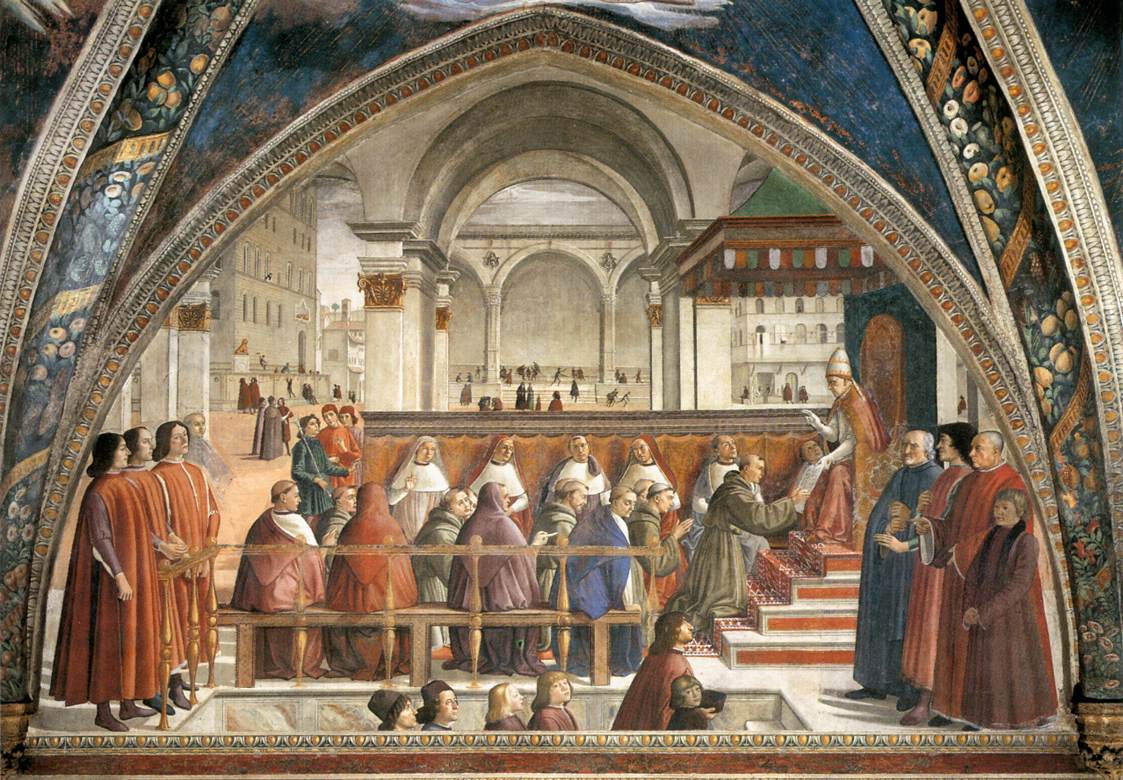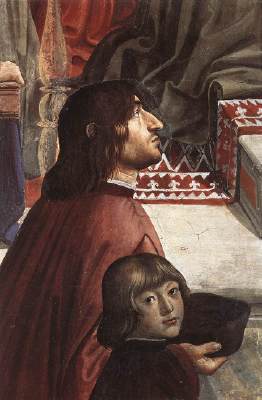
Historical
Oriental Rugs & Carpets
in Medieval European Paintings
Main Page
|
|
Confirmation of the Rule
1482-85
Fresco
Santa TrinitÓ, Florence
by Domenico Ghirlandaio (b. 1449, Firenze, d. 1494, Firenze)


(detail)
At the best site in the chapel, highly visible above the altar, are the most famous scenes of the cycle, though they are not in any way the most important stages of the stories of St Francis. In these scenes Ghirlandaio succeeded in creating his own independent and unique images. Ghirlandaio moves the scene of the represented events from Rome where they took place to Florence.
The events in the Confirmation of the Rule are taking place on the most important square in Florence, the Piazza della Signoria. The fresco represents the visit of the Saint to Rome to obtain the confirmation of his order from pope Honorius III.
In the centre is the consistory hall decorated with gold drapes, and with prelates and personages witnessing the pope's blessing. The Medici family are also present, honouring Sassetti. Lorenzo de' Medici the Magnificent is easily recognizable on the right side, his profile rendered unhandsome by that squashed nose which deprived him (and his mother) of any sense of taste or smell and meant that he always spoke hoarsely, and his olive-complexioned face framed by a brown shock of rather shaggy hair. To his right is Antonio Pucci, now somewhat advanced in years, and Francesco Sassetti dressed in red; his young son Teodoro is by his side.
On the left, dressed in red, stand the sons of the donor: Galeozzo, Cosimo, and also Teodoro, who had already died in 1478. In order to be able to fit all figures into the picture, some of the figures that had already been painted in the fresco had to be scratched off the wall. Thus, next to the donor's sons, there appears a monk without a body: he had been overpainted, but can now be seen again shining through the insufficiently thick layer of colour that was painted over him.
Coming up the steps with their tutor are Lorenzo's two elder sons, Piero and Giovanni, and with them Giulio, the orphan of Giuliano who was killed in the Pazzi conspiracy, with their blond mops of hair, the solemn face of the former and the rather vague expression of the other who follows. Their tutor is Agnolo Poliziano, a man of letters, the composer of the 'Stanze', and a friend of Lorenzo who honoured him in his house.
The three boys are with Matteo Franco, the kinder and more favoured tutor, whose descriptions with the pen accompany Domenico's paint-brush that lingers with such affectionate care on the pinkish, childlike features. The same precision is repeated by Ghirlandaio in the sharp profile of Franco's sworn enemy, Luigi Pulci, a caustic and irreverent character whose soul was imbued with a violent laical paganism. Harsh, bitter, poor and melancholy, he was protected mainly by Lucrezia Tornabuoni.
In the background is Florence, with its most celebrated buildings: the Loggia dei Lanzia, the fašade of Palazzo Vecchio with its solemn raised podium that was later replaced by the present-day flight of steps; the gilded Marzocco lion (symbol of Florentine democracy); a back-drop of houses in the far left-hand corner and a bell-tower (possibly that of San Piero Scheraggio) where the Uffizi would later be built. In the background is a bustling of small figures, citizens and curious onlookers, possibly an opening and closing of shutters and, in places, a glimmering of gold in the capitals and arch of the consistory hall. A faint clear light passes over the soft colours, mellowing even the severity of the stones in the distant buildings. It is the history of Florence, fixed for ever, that passes by and comes to rest in front of us.